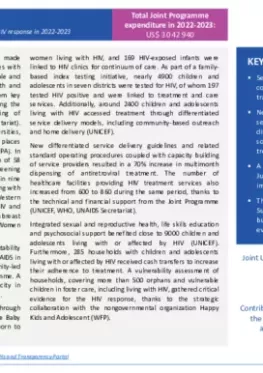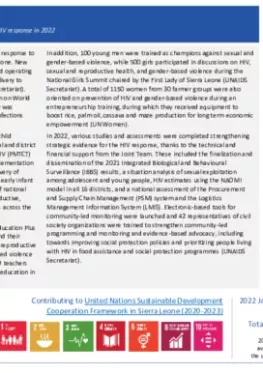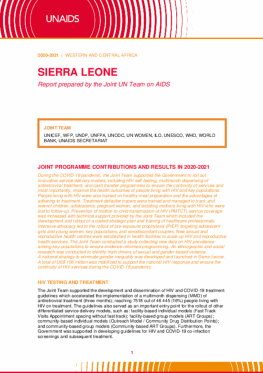|
Sierra Leone
With the Joint Programme’s support, Sierra Leone made encouraging progress in scaling up access to HIV services with focus on gathering evidence and empowering vulnerable and key communities to advocate for their rights to health and social support services. More than 10 200 people from key populations accessed pre-exposure prophylaxis following the development of guidelines and the capacity building of healthcare providers (UNICEF, WHO, UNAIDS Secretariat). Moreover, 100 condom dispensers were installed in universities, parking areas, key populations hotspots and other public places improving access to HIV prevention commodities (UNFPA). In addition, 1800 students benefited from the distribution of 58 000 condoms, while 42 students had cervical cancer screening as part of HIV prevention service packages implemented in nine academic institutions (UNFPA). A total of 512 women living with HIV, female sex workers and community women in Western Area Urban and Rural districts accessed testing for HIV and other sexually transmitted infections, and benefited from breast and cervical cancer screening provided by the Well Women Clinic (UNAIDS Secretariat).
The Government developed a national accountability framework and a 2-5 year priority action plan for ending AIDS in children by 2030, focusing on scaling up community-led responses, with technical support from the Joint Programme. A total of 125 healthcare workers improved their capacity in managing paediatric HIV and referrals to support services.
Thanks to the Joint Programme’s support, including through capacity building and provision of test kits, Special Care Baby Units performed over 2670 HIV tests among babies born to women living with HIV, and 169 HIV-exposed infants were linked to HIV clinics for continuum of care. As part of a family-based index testing initiative, nearly 4900 children and adolescents in seven districts were tested for HIV, of whom 197 tested HIV positive and were linked to treatment and care services. Additionally, around 2400 children and adolescents living with HIV accessed treatment through differentiated service delivery models, including community-based outreach and home delivery (UNICEF).
New differentiated service delivery guidelines and related standard operating procedures coupled with capacity building of service providers resulted in a 70% increase in multimonth dispensing of antiretroviral treatment. The number of healthcare facilities providing HIV treatment services also increased from 600 to 860 during the same period, thanks to the technical and financial support from the Joint Programme (UNICEF, WHO, UNAIDS Secretariat).
Integrated sexual and reproductive health, life skills education and psychosocial support benefited close to 9000 children and adolescents living with or affected by HIV (UNICEF). Furthermore, 285 households with children and adolescents living with or affected by HIV received cash transfers to increase their adherence to treatment. A vulnerability assessment of households, covering more than 500 orphans and vulnerable children in foster care, including living with HIV, gathered critical evidence for the HIV response, thanks to the strategic collaboration with the nongovernmental organization Happy Kids and Adolescent (WFP).
A pilot comprehensive sexuality education (CSE) initiative was implemented in basic and secondary schools in the Koinadugu and Pujehun districts following the development of a national CSE curriculum and related teacher’s manual, and the completion of a training of trainers. A communication framework also facilitated the engagement of 246 community members to further promote CSE in communities and help address high rates of teenage pregnancy and child marriage (UNFPA). In addition, 100 young men were trained as champions against sexual and gender-based violence while over 1500 adolescent girls engaged in discussions on adolescent sexual and reproductive health and rights through dialogue sessions and annual Girls Summits led by the Gender Advocacy Network (GADNET) and the West African Women and Girls Network with mentorship and support from the Joint Programme (UNAIDS Secretariat).
Around 100 people from key populations, including sex workers, gay men and other men who have sex with men, and people who inject drugs were trained on newly developed charters on patients’ and communities’ rights to guide community engagement in the HIV response and ensure access of people to quality HIV services. Another 100 people living with HIV and people from key populations were oriented on treatment literacy and rights (UNDP).
The National HIV/AIDS Secretariat and the Judiciary of Sierra Leone signed a partnership agreement to address inequalities and social injustice impeding access to HIV services with technical contributions from the Joint Programme. Judges and magistrates from across the country also renewed their commitment to address HIV-related stigma and discrimination during a two-day consultation on HIV, human rights and social justice (UNAIDS Secretariat).
An Integrated Biological and Behavioural Surveillance survey was rolled out and showed disproportionately higher HIV prevalence among key populations. Generation of national and global indicators data was strengthened through the revision of HIV tools and configuration of the District Health Information Software (DHIS2), as well as through the training of 40 national and district-level monitoring and evaluation and HIV focal persons on HIV/AIDS strategic information management to monitor progress and identify remaining gaps (UNICEF, UNAIDS Secretariat).
To ensure the sustainability and effectiveness of the HIV response, more than US$ 42.5 million was mobilized from the Global Fund Grant Cycle 7 for the 2024-2027 implementation period.





